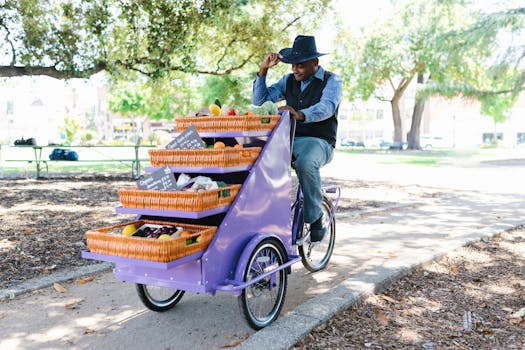Anúncios
Building food resources is crucial for individuals and communities to ensure sustainability and food security. A well-planned approach not only enhances nutrition but also fosters resilience against economic fluctuations.
As food insecurity becomes more prevalent, creating accessible food resources is essential. This article will explore practical steps, inclusive strategies, and collaborative efforts to enhance food availability for all.
From community gardens to food banks, diverse methods exist for establishing robust food systems. Let’s delve into effective strategies to enhance food resources for individuals and communities alike.
Understanding Food Resources
Food resources encompass various food supply systems available in local communities. Understanding what constitutes these resources is vital for effective planning and development.
Food resources include farms, community gardens, grocery stores, and food banks. Each plays a distinct role in ensuring that nutritious food is available for everyone.
Anúncios
Moreover, these resources can significantly impact a community’s health, economy, and environmental sustainability. Thus, emphasizing local food production contributes to overall well-being.
In addition, it’s essential to recognize the disparities in food access. Supporting resources in underserved areas can reduce food deserts and enhance equity.
By working collaboratively with local stakeholders, communities can cultivate a richer food resource landscape, ultimately leading to more resilient systems.
Anúncios
Assessing Local Needs
The first step in building food resources is to assess local needs. Understanding what the community lacks is crucial for creating effective solutions.
Community surveys, interviews, and public forums can provide insight into residents’ food preferences and access challenges. Gathering data allows for informed decision-making.
Additionally, analyzing demographic factors can pinpoint specific requirements, such as cultural food preferences. Tailoring resources to fit these needs is essential for acceptance and success.
Contemplating economic factors is equally important. Areas with high poverty rates may need subsidized food programs to enhance accessibility.
Ultimately, a thorough needs assessment lays the groundwork for developing strategies that address the unique challenges faced by the community.
Engaging Community Members
Engaging community members is paramount in developing sustainable food resources. Fostering a sense of ownership encourages participation and commitment.
Organizing workshops and meetings can help gather community input and ideas. Utilizing local knowledge can lead to innovative solutions tailored to specific needs.
Involving residents in planning and implementation enhances trust and accountability. Successful projects often result from collaborative efforts and shared responsibilities.
Moreover, employing volunteers strengthens community ties. It provides a platform for individuals to contribute to something meaningful while learning about food production.
Collective ownership not only builds resilience but also promotes a sense of pride and connection among community members.
Creating Community Gardens
Community gardens serve as excellent resources for local food production. They provide fresh produce while fostering community engagement and education.
Establishing a community garden begins with finding a suitable location, preferably in an accessible area. Consider vacant lots or parks that can be transformed into productive spaces.
Once a site is secured, forming a committee to oversee the garden’s development ensures organized efforts. Engaging local residents in the planning phase will enhance commitment and support.
Choosing crops that thrive in the local climate is crucial. Diverse planting can offer nutritional variety while making gardening enjoyable for all participants.
Lastly, regular maintenance and community involvement are essential for sustaining the garden. Hosting events can promote camaraderie and invite new members to join.
Developing Food Cooperatives
Food cooperatives are an innovative way to democratize food access. They can play a pivotal role in strengthening local food systems while elevating community ownership.
Creating a food cooperative begins with forming a group of interested members. Each participant contributes toward purchasing food in bulk, reducing costs.
Cooperatives often emphasize local, organic products, providing healthier choices for their members. Additionally, they contribute to supporting local farmers and reducing carbon footprints.
To succeed, educating members about cooperative principles and food systems is essential. This knowledge empowers them to make informed decisions and foster a communal spirit.
Furthermore, food cooperatives can adapt to changing needs, ensuring the resources remain relevant. Community-driven initiatives like this enhance overall sustainability and resilience.
Implementing Food Banks and Pantries
Food banks and pantries serve as vital resources for combating hunger. They provide immediate relief for individuals and families in need.
To establish an effective food bank, partner with local organizations, businesses, and faith communities. Collaborative efforts enhance resource availability and reach.
Regularly assessing the inventory and ensuring diverse options can meet varied nutritional needs. It is essential to include fresh produce, whole grains, and protein sources.
Hosting food drives can help stock supplies and raise community awareness about hunger issues. Involving local schools or businesses can amplify outreach and support.
Furthermore, creating educational programs about nutrition can empower recipients to make healthier food choices, ultimately improving overall well-being.
Utilizing Digital Platforms
Digital platforms play an increasingly important role in connecting individuals with food resources. Utilizing technology can enhance outreach and efficiency in resource distribution.
Creating a website or social media presence allows food initiatives to share information about available resources and events. Engaging content can draw attention and participation.
Online platforms can also provide forums for community dialogues, allowing members to voice concerns and suggestions. This engagement strengthens community relationships.
Additionally, implementing mobile applications can make accessing food resources more convenient. Features like food availability updates can streamline the donation process.
By integrating technology into food resource systems, communities can modernize their approaches and improve access for all residents.
Conclusão
In conclusion, building food resources requires a multifaceted approach that engages communities, assesses local needs, and integrates sustainable practices. Through collaboration and innovation, individuals and groups can catalyze significant change.
From community gardens to digital platforms, many strategies can enhance food security and access. Ultimately, the goal is to create resilient food systems that celebrate diversity and empower community members.
As we move forward, let’s continue fostering partnerships and exploring new avenues for improving food resources. Together, we can cultivate a healthier, more equitable future.



